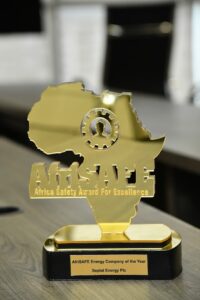Fitch Ratings has affirmed Seplat Petroleum Development Company Plc’s (Seplat) Long-Term Issuer Default Rating (IDR) at ‘B-‘ with a Positive Outlook. Fitch has also affirmed Seplat’s USD350 million 9.25% coupon senior notes due 2023 at ‘B-‘, with a Recovery Rating of ‘RR4’.
The Positive Outlook reflects our view that the Amukpe-to-Escravos oil pipeline, which Seplat now anticipates to be fully commissioned and operational in 2H21, will diversify export routes and mitigate cash-flow volatility. We also view the company’s financial profile to be strong for the rating and if Seplat manages to refinance over the next nine months and spread its maturities so as to be able to survive for more than two years of force majeure, this may support the sustainability of its credit profile without the Escravos pipeline being completed.
In the extreme scenario that the currently primary export route of Trans Forcados is not operational for over a year and with no alternative other than the two jetties at the Warri refinery, we expect Seplat to be able to operate for around 12 months before running out of cash based on the current debt maturity profile. We would also expect in such a scenario that work on the Escravos pipeline will be accelerated.
The rating incorporates the small scale of Seplat’s operations, concentration of asset base in Nigeria (B/Stable) and historically unstable operating environment in the troubled Niger Delta. The rating also reflects moderate leverage, conservative financial policies, competitive unit profitability and a growing domestic gas business.
Key Rating Drivers
Small Nigerian E&P Company: Despite the acquisition of Eland Oil and Gas (Eland), Seplat remains a small oil and gas producer with operations concentrated around the Niger Delta region. The Nigerian oil and gas sector has been characterised by high operational risks and regulatory uncertainty. Its main assets are the Oil Mining Leases (OMLs) 4, 38 & 41, which accounted for around 75% of 9M20 production and are reliant on the Trans Forcados pipeline that was out of operation for more than a year between 2016 and 2017 due to sustained breaches by militants.
Ramp-up to 2023: We expect Seplat to ramp up its daily oil and gas output to around 65kboe/d in 2022-2023 from an estimated 50kboe/d in 2020. Currently, its crude oil production is subject to the OPEC+ cuts (primarily its Eastern assets by 20%). We conservatively assume that Seplat will increase production to around 55kboe/d in 2021 and still remain compliant with the current OPEC+ quotas. We believe that even following Seplat’s expected production ramp-up in 2022, it will remain a small E&P company with a significant onshore asset concentration in one country.
Escravos Pipeline Delayed: Fitch views the completion of the 160kbbl/d third-party-operated Escravos pipeline as a key factor for upgrade. This is because it will reduce over-reliance on one particular export route that had adversely affected business in the past. The Escravos route will materially improve the assets’ production uptime and shrink losses from crude theft and reconciliation. The commissioning of this export route was initially expected in 2014, but several delays to payments between the owners and the contractor, outside of Seplat’s control, has stalled progress.
Difficult Macro Environment Stresses Results: We expect Seplat’s EBITDA to decrease 42% yoy in 2020 on lower oil prices and rising costs from the consolidation of the higher-cost production base of Eland’s OML 40. Despite a challenging macro environment, we expect Seplat to be free cash flow (FCF)-neutral in 2020. Although we forecast funds from operations (FFO) net leverage to increase to 2.4x at end-2020 we expect it to average 1.3x in 2021-2023, remaining strong for the rating.
Cost Optimisation Ongoing: Seplat is undertaking cost-cutting measures and identifying synergies within its newly acquired Eland assets to reduce its cost base. With the acquisition of Eland, Seplat’s operating expenditure increased to around USD8.73/boe in 3Q20 from about USD6.2/boe in 2019. Cost optimisations include supplier cost savings, water management optimisation, barging cost reduction along with legal and other similar cost savings.
Alternative Routes De-risk Operations: The Escravos pipeline will allow additional oil exports of 40kbbl/d and will be used together with the Trans Forcados pipeline as the main export routes. We regard the usage of the more costly Warri refinery route, which allow exports of 30kbbl/d gross, as unlikely unless force majeure occurs. Furthermore, the Eland acquisition provides the opportunity to develop its own export route and offshore terminal, leveraging the Amukpe to Escravos pipeline where together the OMLs 4, 38, 41 and OML 40 crude could be evacuated.
Inorganic Growth: We expect management to continue to actively seek opportunities for inorganic growth, mainly onshore and shallow water offshore in Nigeria but also abroad without compromising the current ratings. Domestic opportunities exist as oil majors continue to streamline their portfolios, exiting Nigeria. We view Seplat’s financial policies as conservative for the rating category, underpinned by debt-reduction initiatives, as well as flexibility to suspend dividends and cutting capex during the troubled 2016-2017 period. We consider acquisitions an event risk.
Growing Gas Business Provides Stability: Fitch views positively the growing share of natural gas in the production mix as contracted offtake volumes and pricing enhance stability and visibility of FFO. Seplat currently supplies about 30% of the Nigerian gas to power volumes, a market that is set for strong growth. The 50-50 ANOH gas development JV between Seplat and Nigerian Gas Company Limited (NGC) underpins Seplat’s effort to further expand gas operations, adding 300mmscf/d to the existing 525mmscf/d gross wet gas processing capacity. The facility is on track to be commissioned towards end-2021.
ANOH Funding Being Finalised: The JV partners are currently in the process of finalising USD320 million of non-recourse debt financing to fund the remaining of this USD700 million project. Seplat expects to start receiving dividends from 2022, although we conservatively do not include any contribution in our rating case.
ESG – Social: Seplat has an ESG Relevance score of 5 for Human Rights, Community Relations, Access & Affordability due to its focus on upstream operations in the troubled Niger Delta region of Nigeria. Historically, this area has been a high-risk environment driven by militancy, crude oil theft, pipeline sabotage, as well as environmental pollution arising from militant strikes against oil infrastructure. This has a negative impact on its credit profile and is highly relevant to the ratings. The completion of the new alternative pipeline will support a positive rating action.
The Trans Forcados pipeline, the company’s primary export route, was shut down for 305 days in 2016 and more than 182 days in 2017, adversely affecting Seplat’s operations. Deeper communication and cooperation between the government, the companies and local communities have since seen a significant reduction in targeted attacks on oil infrastructure. Militancy activities reduced significantly since the force majeure and the Trans Forcados export system saw an improved uptime of 77% in 9M20 compared with 50% in 2017.
Derivation Summary
Onshore Nigeria-based Seplat is a small oil & gas E&P company by production and reserves.
We rate Ithaca Energy Ltd (B/RWN) one notch above Seplat as Ithaca benefits from lower leverage, a more robust hedging position, higher production volumes (2020F: 67kboe/d) and focus on the UK North Sea, which is a more stable operating environment compared with that of Seplat, which only focuses on Nigeria. This is partially mitigated by Seplat’s bigger reserve base and higher reserve life (Ithaca: 4 years on a 1P basis). Ithaca is on RWN as we see potential liquidity pressure and deterioration of the financial profile stemming from liquidity issues experienced by its 100% parent Delek Group.
Compared with Kosmos Energy Ltd. (B/Negative), Seplat has bigger reserve base, higher reserve life and stronger credit metrics with no material maturities until the beginning of 2022. These strengths are offset by Kosmos’ more diversified asset base in a more predictable business and operating environment – including the US – compared with Seplat’s high exposure and concentration to areas characterised by geopolitical risk. Kosmos’ Negative Outlook reflects our expectation of adverse impact on the company’s liquidity profile from limited access to committed liquidity sources as well as uncertainties around the execution of farm-down transactions.
Key Assumptions
Fitch’s Key Assumptions within our Rating Case for the Issuer:
- Oil price deck of USD41/bbl in 2020, USD45/bbl in 2021, USD50/bbl in 2022, and USD53/bbl in 2023
- Domestic gas prices of about USD2.8/mcf on average until 2023
- Upstream production ramping up to above 65kboe/d in 2022-2023
- Dividends of about USD59 million a year up to 2023
Fitch’s Key Assumptions for Recovery Analysis:
- The recovery analysis assumes that Seplat would be restructured as a going concern rather than liquidated in an event of default
- Seplat’s post-reorganisation, going-concern EBITDA is estimated at around USD223 million, based on the current asset base. A drop in EBITDA to the going-concern level reflects risks associated with hydrocarbon price volatility, potential unplanned downtime and other adverse factors
- We have applied a distressed enterprise value (EV)/EBITDA multiple of 4.5x to calculate a going-concern EV, reflecting a mid-cycle multiple for the natural resources sector in the EMEA region and the risks associated with the operating environment in the country of operation.
- We assume a 10% administrative claim to be deducted from the going-concern EV
- Our principal waterfall analysis assumes the USD350 million senior secured revolving credit facility (RCF) and USD100 million Eland reserve-based lending facility (RBL) rank senior above Seplat’s senior notes
- Taking into account our Country-Specific Treatment of Recovery Ratings Rating Criteria, our waterfall analysis generated a ranked recovery in the ‘RR4’ band, indicating a ‘B-‘ instrument rating. The waterfall analysis output percentage on current metrics and assumptions is 50%.
Rating Sensitivities
Factors that could, individually or collectively, lead to positive rating action/upgrade:
- The successful completion and commencement of the Escravos oil pipeline, positive FCF generation on a sustained basis along with production ramp-up resulting in forecast FFO net leverage remaining below 3.5x, could result in an upgrade of the IDR to ‘B’.
- We may also consider a positive rating action if the company successfully refinances its indebtedness and improves its debt maturity profile so as to be able to survive more than two years of force majeure in the Forcados export system.
Factors that could, individually or collectively, lead to negative rating action/downgrade:
- As the rating is on Positive Outlook, negative rating action is unlikely in the short term. However, failure to maintain FFO net leverage at below 3.5x on a sustained basis or further delay to completion of the Escravos oil pipeline along with insufficient liquidity to cope with protracted operational disruptions could lead to the Outlook being revised to Stable.
- Inability to refinance upcoming maturities would lead to a downgrade.
- Higher-than-forecast downtime as a result of unforeseen events, resulting in material loss of production or downgrades of Nigeria and of local banks where Seplat has historically kept most of its cash could also lead to a negative rating action.
Best/Worst Case Rating Scenario
International scale credit ratings of Non-Financial Corporate issuers have a best-case rating upgrade scenario (defined as the 99th percentile of rating transitions, measured in a positive direction) of three notches over a three-year rating horizon; and a worst-case rating downgrade scenario (defined as the 99th percentile of rating transitions, measured in a negative direction) of four notches over three years.
The complete span of best- and worst-case scenario credit ratings for all rating categories ranges from ‘AAA’ to ‘D’. Best- and worst-case scenario credit ratings are based on historical performance.
Liquidity and Debt Structure
Adequate Liquidity: As at end-September 2020, Seplat had around USD300 million of liquidity, including around USD200 million of readily available cash and USD100 million availability under its USD350 million senior secured RCF that were more than sufficient to cover its short-term debt repayments. The company has minor scheduled debt maturities for the rest of 2020 and 2021.
Seplat is also in the process of refinancing the Eland RBL, which should improve its debt maturity profile further. At end-September 2020, Seplat’s indebtedness stood at USD700 million, including USD350 million of senior notes, USD250 million drawn under its USD350 million senior secured RCF and a fully drawn USD100 million Eland RBL. Our modelling suggests that Seplat will be FCF-neutral in 2020 and FCF-positive after dividends in the subsequent years.
Exposure to Nigerian Banks Reduced: Seplat has historically held most of its cash at Nigerian banks, which have ratings from Fitch of ‘B’/Stable and below. At end-September 2020, about 60% of its cash balances were held offshore and around 85% of its total cash were denominated in US dollars. As a general policy, the company usually retains around 70% of its total cash in US dollars and around 70% of the US dollar cash is held offshore. Nevertheless, we believe that Seplat has large exposure to the Nigerian banking system and we believe that cash holdings at Nigerian banking institutions are vulnerable to a sharp deterioration in oil prices and the naira.
Summary Of Financial Adjustments
Fitch reclassified around USD3 million of depreciation of right-of-use assets and around USD0.5 million of interest on lease liabilities as lease expenses, reducing Fitch-calculated EBITDA by around USD3.5 million in 2019.
Fitch adjusted USD6.7 million cash, subject to legal restrictions, as not being readily available at end-2019.
References For Substantially Material Source Cited As Key Driver Of Rating
The principal sources of information used in the analysis are described in the Applicable Criteria.
ESG Considerations

Seplat has an ESG Relevance Score of 5 for Human Rights, Community Relations, Access & Affordability due to its focus on upstream operations in the troubled Niger Delta region of Nigeria. This has a negative impact on its credit profile and is highly relevant to the ratings. The completion of the new alternative pipeline will support a positive rating action.
Unless otherwise disclosed in this section, the highest level of ESG credit relevance is a score of ‘3’. This means ESG issues are credit-neutral or have only a minimal credit impact on the entity, either due to their nature or the way in which they are being managed by the entity.














